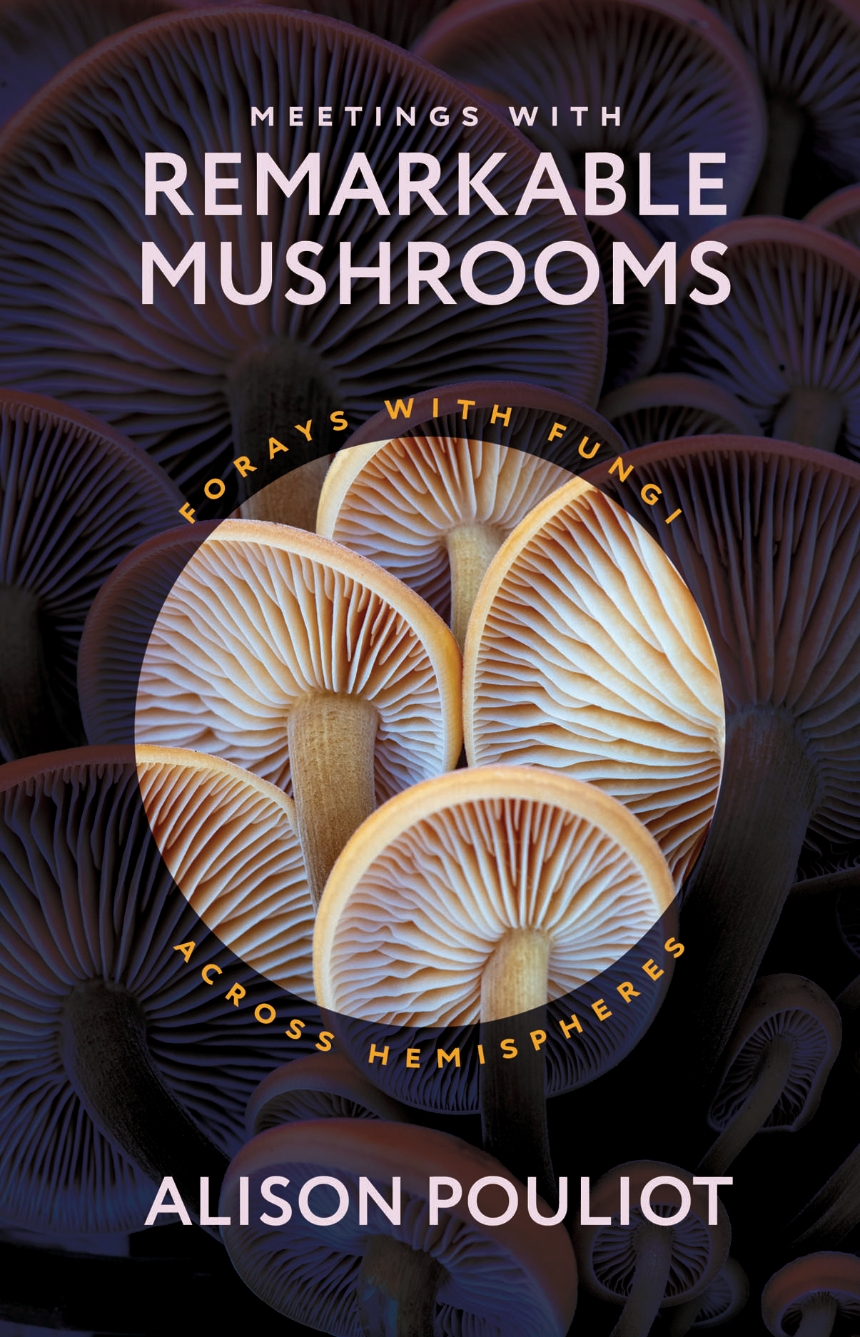Meetings with Remarkable Mushrooms
Forays with Fungi across Hemispheres
A whirlwind journey through fungus frontiers that underscores how appreciating fungi is key to understanding our planet’s power and fragility.
What can we learn from the lives of fungi? Splitting time between the northern and southern hemispheres, ecologist Alison Pouliot ensures that she experiences two autumns per year in the pursuit of fungi—from Australia’s deserts to Iceland’s glaciers to America’s Cascade Mountains. In Meetings with Remarkable Mushrooms, we journey alongside Pouliot, magnifiers in hand, as she travels the world.
With Pouliot as our guide, we smell fire-loving truffles that transform their scent after burning to lure mammals who eat them and, ultimately, spread their spores. We spot the eerie glow of the ghost fungus, a deceptive entity that looks like an edible oyster mushroom but will soon heave back out—along with everything else in your stomach—if you take a bite. And we crawl alongside vegetable caterpillars, which are neither vegetable nor caterpillar but a fungus that devours insects from the inside out.
Featuring stunning color photographs of these mycological miracles, Meetings with Remarkable Mushrooms shows that understanding fungi is fundamental for harmonizing with the natural world.
320 pages | 16 color plates | 5 1/2 x 8 1/2 | © 2023
Biological Sciences: Botany, Conservation, Ecology
Reviews
Table of Contents
1 Stirrings in the Subterrain
2 Life in the Mycosphere
3 Into the Australian Bush
4 No Such Thing as a Bad Fungus
5 Fungi, Fire, and Ice
6 Fungal Renegades
7 The Mycophagists
8 Conserving the Bizarre and the Beautiful
9 Women as Keepers of Fungal Lore
10 Restoring Fungi
Epilogue
Acknowledgments
Images
Species Register
Glossary
Selected Sources
Index
Excerpt
It was raining in Whitby. That was hardly unusual, and I should have been pleased. Everyone knows rain brings mushrooms. Westerly winds swept over the North York Moors, delivering showers in squalls and spurts along England’s Yorkshire coast. I was there for an international congress on fungal conservation and the dampness boded well for fruitful field trips. But I was trying to hitch a ride to the congress dinner and was already late, and the rain ran cold down the back of my neck.
A vehicle appeared, slowed almost to a standstill then sped off, spraying me with water. The road returned to darkness. Gulls mewed in the distance as another vehicle approached, blinding me with its headlights, but it slowed and stopped. I ran toward it. It was only when the tailgate flipped down and the back window flipped up that I saw it was a hearse.
“Well get in then!” barked a voice in a North Yorkshire accent. I probably should have hesitated, but I didn’t. I leapt in and cracked my knee on something hard. It was a coffin. A coffin in a hearse shouldn’t seem odd. But the three goths sitting bolt upright inside it drinking champagne did. They eyed me suspiciously as one passed me a glass. He filled it to the brim and champagne overflowed down my sleeve. “So where’d you be goin’ this fine evenin’?” he asked. My knee throbbed and I could feel my hair stuck to the sides of my face as I shook out my sleeve. “To a congress dinner on the quay,” I replied, then added, “a congress on fungi!” He squinted and pursed his blackened lips. No one spoke. The windscreen wipers flapped louder.
You’d have thought that with our common interest in the subterrain, I’d landed with kin, but the other two goths glanced sideways, and one raised an eyebrow. It seemed the fungus congress and the Whitby Goth Weekend had been programmed simultaneously and we each thought the other the more strange. But after a prolonged silence, the questions about fungi came thick and fast until the driver cranked up the stereo and The Sisters of Mercy saved me from further interrogation.
As we turned onto the quay, I caught sight of the ruined Whitby Abbey perched high on the headland overlooking the North Sea. Pedestrians dashed across the wet road. “Here! Stop here, please!” I yelled to the driver and he pulled into the curb. I handed back my glass and wished the goths well. They nodded in unison as I climbed out of the hearse. Back in the rain, I paused for a moment to gather myself, then headed toward the lights of the restaurant, certain that my foray into fungal realms would be every bit as thrilling as the ride.
The International Society for Fungal Conservation Congress drew a motley band of conservationists, fungus enthusiasts, and mycologists—scientists who study fungi— from the forest and the laboratory to David Minter’s hometown of Whitby. David is a mycologist and the mastermind of the society. A natural-born showman, he’s good at holding court, convincing anyone who might not yet be convinced that fungi should be at the heart of biodiversity conservation, not the periphery.
David has been fighting for fungi and their recognition for a long time. Fungi seldom feature in conservation because they seldom feature in our ideas about what that thing out the window—nature, biodiversity, the environment, whatever you want to call it—actually is. But by only considering above- ground ecologies of plants and animals, what if we were failing to protect the diversity of fungi below ground? What if this oversight meant a slow, unseen unraveling of the very foundation that enables all aboveground life to flourish? Even the scientists who study organisms other than fungi and the conservationists who rally for them are usually largely unaware of the need to conserve fungi. However, given most of those organisms are intertwined with fungi in some way, including fungi in conservation makes good sense.
